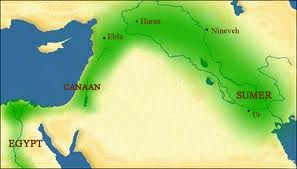Introduction to Ancient Hebrews
The Hebrews, who settled in Palestine about
4000 years ago, were a nomadic tribe that came from southern Mesopotamia. They
were among the many peoples who lived in the Fertile Crescent. Hebrew came from the Hebrew word Ibri, which means people who passed
over, or people from the other side. Their story is told in the Bible.
The
Old Testament mentions that the first Hebrew was Abraham, who lived in the
Sumerian city of Ur. Travelling with his family, he came to Syria, then to
Canaan (Palestine), where he eventually settled. His grandson Jacob (Israel)
had twelve sons after whom the twelve tribes of Israel were named. A famine in
Canaan resulted in Jacob leading his people to safety in Egypt.
The Hebrews are
also called Israelites.
The Israelites later became slaves in Egypt, until a
religious leader named Moses brought them back to Canaan. Before they could
establish their settlement in Canaan, however, they had to fight off all the
people occupying the land, which they believed was promised to them by God.
For forty years, the
Hebrews wandered in the Sinai Desert. During this time, Moses received many
laws, including the Ten Commandments. After the death of Moses, Joshua
succeeded him. The Israelites finally entered the Promised Land under Joshua’s
leadership.
The
Israelites had set up a kingdom around 1000 BC. Under three kings—Saul, David,
and Solomon—Israel prospered. David, who, tradition has it, was a shepherd who
became famous for defeating the Philistine giant Goliath, united the tribes of
Israel into one nation and made Jerusalem its capital. Solomon, David’s son,
made Jerusalem into an impressive city, and built a magnificent temple
dedicated to God. While at it, he also built an extravagant palace for himself.
King Solomon is famous for his legendary wisdom. He negotiated with powerful
empires in Egypt and Mesopotamia, in the process increased the kingdom’s
influence.
Solomon’s
structures and extravagance, however, took its toll on the Israelites. Heavy
taxes and much forced labor were required to support such projects. Eventually,
revolts erupted soon after his death around 930 BC. The kingdom split into two:
Israel to the north and Judah to the south. This disunity severely weakened
Israel. The Hebrews were not able to fight off the invading armies that
followed.
Israel fell to the
Assyrians in 722 BC, while Judah was conquered by the Babylonians in 586 BC.
Jerusalem’s temple was destroyed by King Nebuchadnezzar, and many Israelites
were forced into exile. During their captivity, the Israelites became known as
Jews. The term Jew comes from the
Hebrew Yehudi, which originally referred to the tribe of
Judah. This exile was the start of the Jewish Diaspora.
 |
| Sculpture of Cyrus the Great |
Fifty
years later, in 538 BC, the Persian ruler Cyrus the Great allowed many Jews to
return to Israel and rebuild their temple. After Alexander conquered the
Persian Empire, Israel fell under the control of the Greeks. Like many other
small groups in the region, they continued to live under a series of foreign
conquerors—the Persians, the Greeks, and the Romans.
The
king of ancient Israel was not an absolute monarch. He had to obey the Torah, which contains the first five
books of the Old Testament, and contains laws, both religious and secular. The
Israelites viewed the Torah as God’s revealed instruction to Israel, and not
even the king was above it. If the king’s commandment was in direct violation
of the Torah, the ministers were not
duty-bound to enforce it. The Sanhedrin
acted as the supreme court of Israel.
Like other Bronze and Iron Age populations,
the economy of ancient Israel was dependent on agriculture. The production of
valuable trade goods such as jewelry or weapons made from metals was also vital
to their economy, as well as ceramics, field labor and craft production.
Ancient Israel had no
public buildings during this period, and central government was still in the
nation’s future. As a result, the family was the most important social
structure during this time. Families lived in small houses, and connected by a
courtyard to the houses of close relatives.
The home in ancient
Israel was central to education, work, and leisure. The ideal Israelite family,
according to the Bible, was large and patriarchal; however, excavated
structures from this period suggest that average family size consisted of only
four to eight people. High mortality rates and a short lifespan kept most
families from achieving the biblical ideal.
Women in ancient
Israel usually spent much time in their homes, processing the raw food
materials that the men brought in from the fields. They were responsible for
making sure that the food the men brought in will last until the next harvest.
Childcare and daily upbringing were mainly the responsibility of women, since
men were out in the fields or fulfilling their military duty. The husband was
obligated to support his wife, although she could own property. Marriage was
assumed to be an economic partnership, among others. If the husband could not
pay his debts and went bankrupt, he, along with his wife, could be sold into
slavery.
We can assume that
the wife also worked hard to help her husband from going bankrupt, and prevent
this unhappy event.
Education in Ancient
Israel was centered on religion. The beth
ha-sepher (or heder) was a
community-maintained elementary school. Elementary education started at the age
of six; a school for boys from ages 15-17 was also established. To those who
wanted to further their study, a rabbinic
education (rabbinic--pertaining to the Jewish religious leader, the rabbi) was provided in the Bet Ha-Midrash (House of Study), usually located close to the synagogue.
In addition, the father is required by law to teach his sons not only the Torah, but a trade as well. The
daughter’s early education, on the other hand, was mainly the responsibility of
the mother.
The Hebrews has had a great impact
on history, despite their comparatively insignificant origins and resources.
Their religion, Judaism, greatly influenced two other major
religions—Christianity and Islam. The Old Testament derives from early Hebrew
scriptures. The Bible is the greatest single influence on religion, ethics, and
literature of the Western world; the three major religions of the world are all
rooted in it.
Judaism, the religion of the
Hebrews, is monotheistic; that is, they worship one God—Yahweh, creator of
everything. Through Abraham, God made a covenant,
or a promise, with the Hebrews: Abraham and his descendants will be the Chosen
People, and that Yahweh will protect them, in return for obedience. Moses later
renewed this covenant; the Ten Commandments, and other laws, were part of this
covenant with God. Judaism does not permit God’s representation through images.
Early Hebrews believed that they alone lived under God’s protection, for they
were His chosen people. Later, they believed that their God was also the God of
all people, and of the universe. Because of this belief (of one God for all), the
Hebrews came to believe that one must love not only one’s neighbor, but one’s
enemy as well—an entirely new idea.
 Other stories in the Bible—the Creation, the temptation and sin of the first humans (and their expulsion from
an idyllic “garden”), the Flood—have similarities with the legends of other earlier civilizations. Abraham, however, introduced the concept of one God in
an age where polytheism was the norm. Akhenaton in Egypt and Zoroaster, if you
remember, had the same idea (belief in one god), but the religions they founded
did not have the impact that Judaism had to the world.
Other stories in the Bible—the Creation, the temptation and sin of the first humans (and their expulsion from
an idyllic “garden”), the Flood—have similarities with the legends of other earlier civilizations. Abraham, however, introduced the concept of one God in
an age where polytheism was the norm. Akhenaton in Egypt and Zoroaster, if you
remember, had the same idea (belief in one god), but the religions they founded
did not have the impact that Judaism had to the world.
Music played a large part in the
culture of ancient Israel. The Bible, in fact, is rich with references to music
and the role that it played with the social, political, and religious aspects
of ancient Israel. Returning warriors, especially during the time of David,
were often welcomed by singing and dancing women. Worship of course would not
be complete without music, as well as the celebrations, like thanksgiving for a
bountiful harvest, marriage, and others. The destruction of the Temple by the
Romans in A. D. 70, however, made the Israelites abandon the music that they
had so loved.
From A. D. 66 to 70, the Jews
rebelled against their Roman conquerors. In the savage fighting that ensued,
Jerusalem was largely destroyed. The remaining Jews were again driven into
exile; the Diaspora was at its height at this time. Thereafter, the Jews were,
for two thousand years, without a country of their own. They lived among “gentiles,”
becoming the most persecuted people in history. Despite all this, however, they
were able to preserve their own identity—their culture and their religion.
What’s more, they have also outlasted all the other civilizations that were
their ancient contemporaries and left a remarkable legacy of
accomplishments.






Comments
Post a Comment
So, what do you think? Post it here: